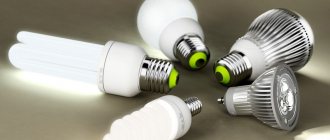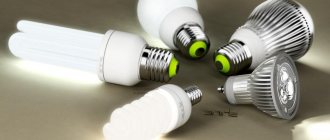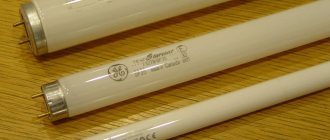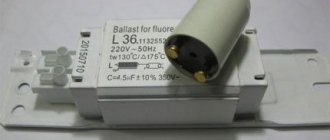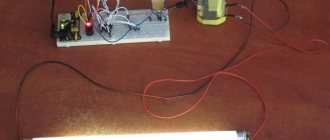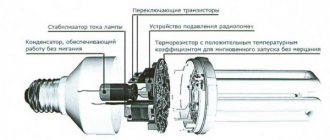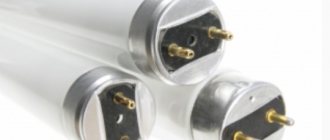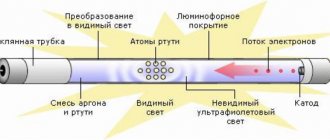We provide comprehensive services based on:
- license No. 077 84 dated April 20, 2022 on actual activities for collection, transportation, processing, disposal, neutralization, disposal of waste of I-IV hazard classes, issued. Federal Service for Supervision of Natural Resources;
- certificate of conformity REG.№КК.RU.0001.СЭМ0221 dated June 24, 2013, issued by the certification body Interregional Certification Body LLC;
- certificate series 77 No. 00071 dated December 20, 2015, issued by the Self-regulatory organization “Waste Recycling Association”
Consequences of improper disposal of energy-saving light bulbs
Spent fluorescent and other mercury-containing lamps are classified as extremely hazardous waste .
Throwing burnt out and damaged lighting sources along with other household waste into a garbage chute or standard containers is strictly prohibited .
licensed organizations have the right to transport and dispose of them .
The consequences of such devices ending up in landfills along with household waste are catastrophic for the environment. Toxic substances , getting from damaged products into the environment, pollute everything around:
- soil,
- atmosphere,
- water resources,
- biosphere.
Mercury poisoning is especially dangerous. When mercury-containing lamps are discarded in a landfill or down a sewer system and their seals are broken, they contaminate hectares of soil surface. Mercury seeps into groundwater and wastewater and inevitably ends up in water bodies.
In addition to contamination from the atmosphere and water, large doses of mercury enter the human body through food. The greatest amount of poison is found in fish and seafood that live in polluted waters.
The most dangerous feature of mercury is that, accumulating in the body, it is practically not eliminated from it, forming maximum toxic concentrations . In case of poisoning, the following are most affected:
- nervous system,
- digestive system,
- lungs,
- kidneys,
- immunity suffers
Mercury compounds are especially dangerous for female reproductive function.
Dangerous chemical composition
The lamp device operates on the basis of oxides of strontium, barium and gas, which are mixed with mercury. To make the lamp shine, a phosphor substance is applied inside. The brightness of the source depends on its thickness.
The lamp tubes are equipped with 3-4 g of mercury. Containing a hazardous component carries a health risk if damaged.
Important! Mercury belongs to class 1 hazardous substances.
The spill poses a major threat to the environment. Mercury accumulates in the soil, permeates groundwater, flows from it into water bodies, and infects fish. Therefore, it becomes obvious that fluorescent lamps must be recycled.
Types of lamps containing mercury
All fluorescent energy-saving fluorescent lamps contain mercury.
Fluorescent lamps are filled with an inert gas , usually argon, and contain from 1 to 70 mg of silvery liquid metal.
On average, a typical household fluorescent light bulb contains 3-5 mg of mercury .
The inner surface of the product is coated with phosphor:
- calcium halophosphate,
- Calcium-zinc orthophosphate.
If one lamp is broken in an isolated room or office, the mercury content in the atmosphere can exceed the maximum permissible standards for several hours by more than 150 times and reach 0.05 mg/m³.
The following types of lamps also contain mercury:
- xenon,
- bactericidal,
- neon.
Depending on their purpose, various materials for the manufacture of flasks and different filler gases , but the only component remains unchanged - mercury.
LED
LED lamps are the most environmentally friendly .
No mercury is used in their production. There are no special requirements for transportation and disposal of such products.
The base of such lamps contains a stabilizer and other electronic components that can be recycled .
Therefore, it is advisable to dispose of these types of products as hazardous waste, although this is not required by law.
However, in some types of LED lamps used in decorative garlands and automotive lighting devices, to reduce the cost of production they use:
- lead,
- m,
- other potentially hazardous substances.
Incandescent and halogen
Incandescent lamps, due to their low efficiency (about 5%), have recently been replaced by more efficient light sources , but their undoubted advantage remains their environmental friendliness.
The light source in this type of product is a tungsten filament, and the lamp itself is filled with inert gases.
A special type of incandescent lamp is the halogen lamp. Their peculiarity is that the lamp bulb is filled with halogens or their derivatives .
The use of these gases made it possible to extend the operating time of the product and increase efficiency by up to 15%.
Burnt-out incandescent light bulbs are safe and do not require special disposal , although recycling them also provides raw materials that can be reused.
Are you planning to build?
Read our material about the production of environmentally friendly sawdust concrete. An old computer, a broken printer, an ancient copier... They have no place in the trash. Read the article about recycling office equipment here.We will cover all aspects of the charcoal production business: https://rcycle.net/drevesina/proizvodstvo-drevesnogo-uglya-kak-biznes
If the lamp is damaged
The high efficiency of an energy-saving lamp does not guarantee its continued integrity. It's safe as long as it's whole. If the device breaks, there is a risk of mercury contamination. Urgent measures need to be taken.
Precautionary measures
Mercury vapor from lamps is more dangerous than the substance itself. They immediately enter the respiratory system and affect the body. The following actions are required:
- Ventilate the room for 2 hours with the windows open.
- Leave the premises with your pets.
Do not visit the contaminated area until it has completely evaporated.
Features of recycling
A damaged device cannot be thrown into the trash and must be disposed of. Actions must be carried out in compliance with safety rules:
- wear a mask and gloves;
- collect fragments and parts;
- remove mercury with a wet sponge;
- put in a bag and seal tightly;
- Treat surfaces with potassium permanganate;
- disinfect the soles of shoes with a chlorine solution;
- Pack the items used for cleaning in a sealed bag;
- take the packages to a hazardous waste container.
Forbidden:
- use a vacuum cleaner when cleaning;
- dispose through the toilet;
- work without a mask and gloves.
In the absence of special tanks, packaged packages are handed over to collection points.
How to get rid of it?
If the bulb of a mercury-containing lamp is damaged, you must:
- ensure ventilation of the room ;
- carefully collect large fragments ;
- small parts of the lamp with adhesive tape, disposable towels, napkins, and do not use a vacuum cleaner;
- carry out wet cleaning with chlorine-containing preparations.
Do not throw away the remains of mercury-containing lamps and materials used for cleaning along with household waste or flush them down the drain! Both broken and undamaged burnt-out lamps should be packed in a cardboard box and taken to special collection points.
You can donate the lamp to:
- Special containers under the management company, DEZ, REU. Acceptance of lamps from the public is free .
- Reception points for specialized organizations licensed to transport and dispose of hazardous waste.
- Collection points at stores selling such lamps. The most famous are IKEA, “220 volts”. In many of these points you can not only return your old light bulb for free, but also get a discount on the purchase of a new lamp .
Organizations, as well as individual entrepreneurs, must enter into agreements providing for the disposal of hazardous waste (including devices containing mercury) with licensed enterprises.
For violation of these norms, a legal entity may be subject to a fine of up to 250 thousand rubles in accordance with the Code of Administrative Offenses of the Russian Federation.
Organizations and reception points in major cities of Russia
So, where can you donate energy-saving lamps, and where are fluorescent lamps recycled in Moscow, St. Petersburg and other cities?
The list of such companies is given in the table:
| City | Organization | Address, contacts |
| Moscow | LLC NPP "Ekotrom" | Warsaw highway, 93(495)374-62-35 |
| LLC "Venture | Moscow region, Dubna, st. Academician Baldina, 7/1 (963)764-41-56 | |
| LLC "NPEF "EkON" | st. Novoposelkovaya, 6-217 | |
| LLC "Mercom" | Moscow region, Lytkarino, Turaevo village (495)587-1350 | |
| LLC EP "Inter Green" | st. 1st Dubrovskaya, 13a/2 | |
| Saint Petersburg | LLC "First Ecological Service" | Shown in a separate table below |
| Novosibirsk | LLC "SibRtut" | st. Taiginskaya, 3 (383)367‒19‒08 |
| Ekaterinburg | LLC "Spetsavtokom" | st. Repina, 42 A, office 601 |
| Ekaterinburg Municipal Unitary Enterprise | st. Alpinistov, 57a | |
| Nizhny Novgorod | City hazardous waste collection points | st. Ivanova, 12; |
| st. Factory Park, 6 | ||
| Kazan | Viking LLC | st. Adela Kutuya, 116 |
| "Comfort technology" | st. Kosmonavtov, 6a | |
| Chelyabinsk | Meriz LLC | st. Komarovsky, 5 |
| Voir LLC | st. Vostretsova, 3 | |
| Light store "Luch" | st. Darvina, 2, sector No. 124 | |
| Pobeda Ave., 325 | ||
| st. Sverdlovsky tract, 5, sector No. 11 | ||
| Omsk | City collection points | st. Pushkina, 67, st. Chelyuskintsev, 93 |
| st. Koneva, 14 | ||
| st. B. Khmelnitsky, 232a | ||
| Ave. K. Marx, 82 | ||
| st. Magistralnaya, 2 | ||
| Merck LLC | st. Red Path, 163 | |
| Samara | State Unitary Enterprise "Ecology" | st. Michurina 74 |
| Rostov-on-Don | LLC "Fund "Ecology of the Don" | st. Serafimovicha, 53-a |
| LLC PPF "Technoecologist" | st. Trolleybusnaya 24/V, office. 812, tel. 207-02-42 | |
| Eco-Spas Bataysk LLC | st. Kurskaya, 12 |
Also, in many large cities of Russia, on the basis of environmental programs implemented by the authorities, there are “Ecomobiles” - mobile collection points for fluorescent lamps. These are vehicles equipped with special containers. They can also help with recycling your old car battery and batteries. Collection for disposal of mercury lamps is carried out according to the established schedule and route.
The average price for recycling a mercury-containing (mercury) lamp is usually from 15 to 30 rubles. for 1 piece, the cost of recycling other types of energy-saving light bulbs is not much different from these prices.
Closing of Ecostroy, and where else can you turn in St. Petersburg
State Unitary Enterprise Ecostroy, which is engaged in the recycling of mercury and energy-saving lamps in St. Petersburg and implements the Ecomobile program, has stopped accepting mercury-containing devices.
This happened in connection with the optimization carried out by the management of St. Petersburg.
The basis is the Decree of the Government of St. Petersburg dated 03/09/2017 No. 127 “On measures to improve public administration in the areas of improvement, environmental management and environmental protection and amendments to some resolutions of the Government of St. Petersburg”, more details here.
This document transfers all powers in the area of functioning of the hazardous waste collection system to the Committee on Natural Resources, Environmental Protection and Environmental Safety.
In this regard, SUE Ecostroy is completing the provision of services to ensure the functioning of the system for collecting hazardous waste from the population of St. Petersburg from February 16, 2022.
Because of this, the Ecomobile program is terminated and the collection point of the State Unitary Enterprise Ecostroy is closed.
According to one of the city administration officials, the redistribution of powers will not only not deprive citizens of the opportunity to hand over mercury-containing electrical appliances and old batteries, but will also improve it.
After all, now, instead of the State Unitary Enterprise Ecostroy,
the same work is performed by First Ecological Service LLC .
The company's management promises to renew the eco-car program.
Moreover, they promise to increase the number of mobile collection points to 7.
In addition, on their website you will find:
- schedule and parking locations for eco-mobiles;
- addresses and opening hours of stationary collection points for mercury-containing waste.
You can also donate old thermometers and car batteries there.
We have also prepared a list of companies that operate in St. Petersburg and offer recycling services for mercury-containing electrical appliances. In the table you will find:
- name of the enterprise;
- address and contact phone number;
- website.
All information was taken from the official websites of these enterprises, so we recommend visiting the website and calling before your trip . After all, it also happens that a company has already ceased its activities, and its website remains up for several years, misleading people.
| Company name | Address and telephone |
| Ecoproject LLC | Kantemirovskaya street, building 4, 6th floor, office 7, tel (812) 718-27-61, |
| LLC "Ecological Enterprise Mercury" | 5th Rybatsky proezd, 18 (Nevskoye electric depot) Tel: (812) 700-43-11; 700-44-98; 367-79-02 |
| Group | Komendantsky pr., 9/2, lit. Ah, pom. 12 N, TC Promenade, tel. |
| UNEP LLC | st. Pionerskaya, 30, office. 101, tel: +7(812)235-24-77,+7(812)336-23-51, |
| OJSC "Waste Management" | 7th line V.O., 76, of. 115, tel. |
| ProfService SPb LLC | Stachek Ave. 47, tel. |
| Ecological | Piskarevsky pr., 25, office 500, +7 (812) 980-00-01 |
Disposal cost
Services for the disposal of mercury-containing waste are provided on a commercial basis. The renting party pays.
Table No. 1
| Name | Quantity | Price for 1 piece. (rub.) |
| Fluorescent direct lamp | 250-300 pcs. | 15 |
| DRL lamp | 1 PC. | 18-20 |
| Solarium lamp | 1 PC. | 30-35 |
| Broken mercury lamps (scrap) | 1 PC. | 400 |
Recycling prices may vary by item.
What should those who live outside major cities do?
Reception points for mercury and fluorescent lamps are located in large cities and regional centers, but many people live in small towns and villages, from which a large city is several hundred kilometers away.
There are no collection points for mercury-containing light sources, so we have prepared a list of enterprises that can (and some are simply obliged) to help get rid of them even in rural areas .
In addition, we have prepared recommendations that will help you independently deliver such lamps to the nearest collection point if, for some reason, the responsible persons were unable or unwilling to help you.
Here is a list of enterprises whose employees are involved in the disposal of mercury-containing lamps, and therefore can help in this matter :
- Electrical networks.
- Village or district administration.
- REU or UK
- Ministry of Emergency Situations.
- Hardware or construction stores.
Electrical networks
Regardless of the size of the village or farm, electric lines are laid in it, which means there is an enterprise that must service them . In most cases, the enterprise serves several dozen or even hundreds of settlements occupying the territory of one or several districts.
It always includes a chief power engineer, who is in charge of fluorescent and, less commonly, mercury light sources. Therefore, it is necessary to contact him and ask him for help, because one of the responsibilities of an energy engineer is to control the disposal of such light sources.
Even if at some enterprise it is not the chief power engineer, but an ecologist or other specialist , then it will not be difficult to contact him.
This person has a connection with the company that recycles these lamps, so he may well be able to help get rid of them. Another question is whether he will want to help for free or will expect some kind of reward for his help.
Most likely, you will have to pay for the services of a company involved in the destruction of such light sources and, possibly, compensate the energy company for the cost of transporting the lamps to the disposal site.
Village or district administration
By Decree of the Government of the Russian Federation of September 3, 2010 N 681, this is their direct responsibility (clause 8), therefore any refusal is illegal .
Local administration at any level must inform residents about the time and place of arrival of a special vehicle that will deliver the collected lamps to the processing plant.
If the local administration does not respond in any way to requests for help with the disposal of these items, it is necessary to contact a higher-level administration, but if this does not help, then complain to Rosprirodnadzor and the prosecutor's office .
REU or UK
In villages with multi-storey buildings, the following are required to dispose of mercury-containing lamps:
- management company (MC);
- repair and maintenance department (REU);
- another company that serves them.
This organization must have an agreement with the processing enterprise, so it is enough to come to the REU or Management Company and bring used or faulty light sources, the rest must be done by the employees and management of the organization.
Refusal to accept mercury-containing lamps is illegal, so you must immediately contact Rosprirodnadzor or the prosecutor's office of your area.
Ministry of Emergency Situations
The district department of the Ministry of Emergency Situations is another place where they can help with the disposal of mercury and fluorescent lamps.
Despite the fact that the Ministry of Emergency Situations workers are not involved in the destruction of such light sources, they have contacts with processing plants and the ability to safely deliver lamps to them.
Hardware and construction stores
The owner of any hardware or construction store that offers mercury-containing lamps to customers is required to enter into an agreement for their disposal with a company that provides such services.
Therefore, you can bring used light sources to the store.
However, be prepared for the fact that its owner will try to get rid of this burden . After all, all costs of delivery and disposal will fall on him.
How to transport lamps?
There is no need to take any special safety measures; each light source just needs to be wrapped in several layers of thick cloth or inserted into a cardboard package . After this, all dangerous objects must be placed so that they do not fall during movement and sent to the nearest collection and disposal point.
On the road, avoid sudden acceleration and braking, as well as any maneuvers involving rapid changes in speed or body roll.
These instructions apply only to individuals who decide to independently deliver mercury-containing light sources to a recycling facility.
For enterprises licensed to transport and dispose of this waste, the requirements are completely different.
Therefore, if you want to equip a receiving point in your locality, then you will need to not only obtain all the necessary licenses and permits, but also install a special container in which the lamps will be located during storage and transportation.
The collection point is far away
In large cities, collection points for used fluorescent lamps can be found quite easily. In some regions, there are even eco-mobiles that run along a pre-selected route and collect products for processing. But in small settlements it is sometimes difficult to do this; sometimes it is simply not possible to travel to a distant collection point.
In this situation, a special sealed container (polyethylene bag, container or box) is used in which mercury-containing elements are packaged. The rigid design should prevent depressurization of the packaging due to careless handling. It is then placed in a place inaccessible to small children and pets. It is better to choose a collection point in advance where to hand over harmful products at the first opportunity. Lamps can be stored in this way for up to six months.
Second life - crafts and toys
Since incandescent lamps are made without substances hazardous to human life and health and have an attractive shape, they are often used in various creative projects.
The most popular ideas for implementation:
- hanging mini garden,
- hanging and Christmas tree toys,
- floating vase,
- decorative containers,
- candlestick,
- decorative interior elements,
- mini terrarium.
Transportation and disposal rules
Strict standards have not been approved for citizens to independently transport used light sources to the acceptance point. But there are recommendations that need to be followed:
- Wrap each damaged fluorescent lighting source with thick rags or paper;
- If there are a lot of elements, they need to be packed tightly into a box. The layers and bottom are laid with rags or corrugated cardboard.
- During transportation, avoid shaking, sudden braking or turning.
The activities of enterprises involved in the acceptance, removal and disposal of potentially harmful lighting elements are regulated by law.
Used mercury-containing lamps are transported in covered trucks with the lights on; the speed should not exceed 60 km/h.
The lamps are packed tightly into special containers, which are covered with a tarpaulin. The elements are processed in a vibration crushing machine. The equipment crushes and separates elements into metal components, glass and releases phosphor.
Metal and mercury components are recycled, and glass chips are sent to special landfills for solid waste storage.
The production of energy-saving lamps from recycled materials requires five to six times less energy, water and other resources.
Interesting video on the topic:
Technological processes for recycling mercury-containing lamps
Organizations planning to obtain a license are required to have:
- special buildings or structures for storing and neutralizing hazardous waste;
- equipment and specialized installations;
- equipped transport with appropriate markings (if the organization, in addition to recycling, transports hazardous waste);
- employees with the necessary qualifications and appropriate certificates;
Disposal of hazardous waste, which includes mercury-containing lamps, can only be carried out by enterprises that have received a license to carry out this type of activity. Licensing is carried out by the Federal Service for Supervision of Natural Resources.
As a rule, there are 4 methods for recycling lamps containing mercury:
- Thermal . Calcination of waste in a special installation, followed by extraction of mercury vapor.
- Hydrometallurgical . Mercury is extracted by washing crushed lamps with special solutions.
- Thermal vacuum . The crushed lamps are heated under vacuum conditions, the mercury vapor is collected in a separate compartment and frozen with liquid nitrogen.
- Vibropneumatic. Based on crushing mercury-containing lamps into:
- glass,
- metal bases (aluminum and steel),
- mercury-containing phosphor, which is then thermally purified from mercury.
After fluorescent lamps are disposed of, the following secondary raw materials are obtained:
- broken glass;
- plinths;
- phosphor.
With further processing of these raw materials, construction materials and metal are obtained.
If the bulbs of used lamps are not damaged, then they can be used in the production of new similar products.
Storage of fluorescent lamps
Used equipment must be stored in packaging. It should be whole and dense. Up to 30 devices are allowed in one container. They are laid in a vertical position.
The containers are given a separate room and the locations are marked. They are sorted by model, length and diameter. The storage space should be:
- remote from residential areas;
- do not allow moisture to pass through;
- equipped with ventilation;
- closed from outsiders;
A hazardous waste logbook must be kept.
Let's sum it up
Despite the fact that modern energy-saving lamps are positioned by manufacturers as durable and environmentally friendly light sources , when using them, it is important to remember personal safety and the well-being of the environment.
Electrical mercury-containing lamps must be disposed of in accordance with their hazard class . A responsible approach to use and disposal will not only avoid harming the environment by releasing toxic substances, but will also bring tangible benefits in the form of recycling products.
This is how mercury-containing lamps are disposed of:
Reception points in the regions:
- Stores that sell fluorescent lamps, fluorescent lamps and other items containing heavy metals can accept damaged and used light sources.
- Regional offices of the Ministry of Emergency Situations can accept hazardous waste.
- If there are no stores in your locality that accept hazardous waste and batteries or Eco-mobiles, contact your municipal management company, DEZ or HOA. They are legally required to accept and remove hazardous waste.
- To hand over light bulbs, you can contact organizations that provide operation of electrical communications. Energy companies have specialists who monitor the safety of mercury-containing devices.
- The administration of a district or settlement, if contacted, must pick up and dispose of hazardous waste independently.
The lamp broke, what should I do?
Modern fluorescent and bactericidal lamps have a mercury content of 10 to 70 mg. The best environmentally friendly samples from the LEDVANCE and Philips brands contain about 2.5-3 mg of mercury in one lamp. For comparison, a household mercury thermometer contains about 2 g of mercury.
Most types of discharge lamps contain mercury
However, even if you are dealing with such safe lamps, the release of mercury vapor into the air is always a burden on the body. Therefore, it is imperative to carry out demercurization, i.e., removing mercury from the premises. In the event of a broken lamp, demercurization can be done on your own.
The demercurization procedure at Russian enterprises is regulated by the “Methodological guidelines for monitoring the organization, current and final demercurization and assessing its effectiveness” MP 4545-87. The document was developed back in 1987, but is still in effect.
In everyday life, you can rely on the “Instruction for the population on carrying out demercurization measures in residential premises” issued by Rospotrebnadzor. Similar recommendations can be found on the websites of local governments. When using such recommendations, it should be borne in mind that the sale of potassium permanganate, which is listed there as a demercurization agent, has been limited in Russia since 2007. In fact, it is impossible to buy potassium permanganate, since pharmacies do not want to bother with a bunch of permits for a cheap drug. Of the other products listed in MP 4545-87, the safest option is a soap-soda solution (4% soap solution in 5% aqueous soda solution).
What does lamp recycling have to do with it? Lamp fragments, collected mercury and all items that were used for demercurization are placed in a sealed container and handed over to the management company or to an organization that accepts mercury-containing waste. It is prohibited to throw this waste into the trash yourself.
Some companies that recycle mercury-containing lamps provide a service where a specialist will come to collect the lamp fragments and carry out demercurization. The cost of such a service is from 1500 rubles.
Possible options
Not everyone knows where fluorescent lamps are delivered.
The collection is carried out by certain companies that have a special license. If the flask was broken, the room is ventilated, large fragments are collected, and small parts are removed with adhesive tape or disposable napkins. Then wet cleaning with chlorine-containing products is carried out. Collection points accept lamps in any condition. Remains and debris collection materials must not be disposed of with household waste. All components are sent for recycling. Burnt-out light sources will then be recycled.
Many management companies install free containers to accept light bulbs from the public. Materials are accepted free of charge. Special companies for recycling such devices have a network of collection points throughout the city. In some cases, these organizations also provide assistance with transportation.
You can also donate light bulbs to some chain stores, for example, Ikea or 220 Volt. In return, they provide a discount coupon for the purchase of new lighting sources.
Firms, organizations and individual entrepreneurs enter into agreements that provide for the disposal of hazardous substances. Otherwise, the legal entity faces a fine.
Methods of neutralization
Previously, recycling technology was simple.
The shells of the flasks were washed with water, and it was sent for further processing. During the process, chemical reagents were released that were used for other purposes. Modern techniques make it possible to separate all components. The light bulbs are crushed and put into high-pressure pipes. The air removes all harmful substances, and the phosphor is transferred to another container. The mercury is cooled and used for other purposes.
Some enterprises use a thermal method: the material is finely crushed and calcined at high temperature. Mercury vapor goes into a special “trap” and is frozen. The sockets and phosphor are reused.
Sometimes the hydrometallurgical method is used. Thanks to it, the crushed lamps are washed with special solutions.
It is impossible to neutralize the substance yourself, so recycling at home is impossible. You need to find out the addresses of collection points - they are in city directories.
A competent approach to the problem of using waste allows you to preserve nature. Recycling different devices saves resources and causes less harm to the environment.
Price overview
It can be quite difficult to carry out all of the above points on your own, especially if you want to eliminate lamps in bulk. We propose to consider the cost of recycling fluorescent lamps NNP, DRL, as well as (storage, transportation) offered by city companies. Minimum cost of recycling 1 lamp:
| City | Price, rubles | City | Price, rubles |
| Minsk | 15 | Voronezh | 18 |
| Donetsk | 16 | Almaty | 15 |
| Barnaul | 18 | Bratsk | 15 |
| Volgograd | 15 | Vologda | 15 |
| Dnepropetrovsk | 20 | Ekaterinburg | 15 |
| Izhevsk | 15 | Yoshkar-Ola | 18 |
| Lipetsk | 15 | Irkutsk | 18 |
| Kazan | 18 | Kyiv | 20 |
| Nizhny Novgorod | 18 | Nefteyugansk | 18 |
| Rostov-on-Don | 15 | Moscow | 18 |
| Novosibirsk | 15 | Odessa | 18 |
| Odintsovo | 18 | Omsk | 15 |
| Permian | 18 | Saint Petersburg | 20 |
| Podolsk | 15 | Ryazan | 15 |
| Samara | 15 | Saratov | 18 |
| Sevastopol | 18 | Syktyvkar | 15 |
| Tomsk | 20 | Tyumen | 15 |
| Kharkiv | 18 | Chelyabinsk | 15 |
| Shchelkovo | 15 | Yaroslavl | 15 |
| Balashikha | 15 | Chekhov | 18 |
Ecotron is the most famous company that received the OKPD tender for the recycling of fluorescent lamps GOST 30772-2001. This company organizes demercurization, recycling of solid waste, mercury removal, lamp recycling, prepares documents for business partners, and much more. Consultation is free.
